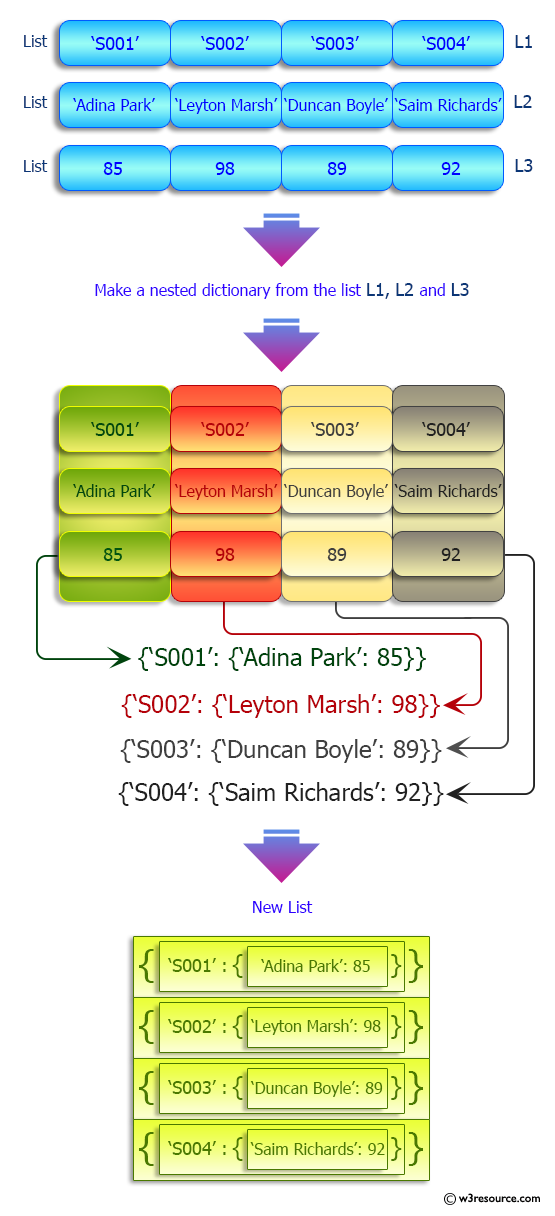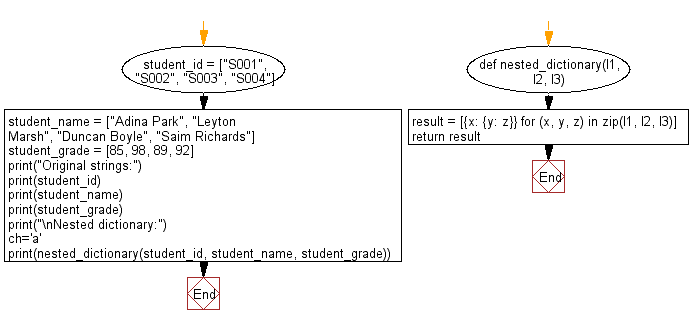Python: Convert more than one list to nested dictionary
Python dictionary: Exercise-43 with Solution
Write a Python program to convert more than one list to nested dictionary.
Sample Solution:
Python Code:
def nested_dictionary(l1, l2, l3):
result = [{x: {y: z}} for (x, y, z) in zip(l1, l2, l3)]
return result
student_id = ["S001", "S002", "S003", "S004"]
student_name = ["Adina Park", "Leyton Marsh", "Duncan Boyle", "Saim Richards"]
student_grade = [85, 98, 89, 92]
print("Original strings:")
print(student_id)
print(student_name)
print(student_grade)
print("\nNested dictionary:")
ch='a'
print(nested_dictionary(student_id, student_name, student_grade))
Sample Output:
Original strings:
['S001', 'S002', 'S003', 'S004']
['Adina Park', 'Leyton Marsh', 'Duncan Boyle', 'Saim Richards']
[85, 98, 89, 92]
Nested dictionary:
[{'S001': {'Adina Park': 85}}, {'S002': {'Leyton Marsh': 98}}, {'S003': {'Duncan Boyle': 89}}, {'S004': {'Saim Richards': 92}}]
Pictorial Presentation:

Flowchart:

Visualize Python code execution:
The following tool visualize what the computer is doing step-by-step as it executes the said program:
Python Code Editor:
Have another way to solve this solution? Contribute your code (and comments) through Disqus.
Previous: Write a Python program to filter a dictionary based on values.
Next: Write a Python program to filter the height and width of students, which are stored in a dictionary.
What is the difficulty level of this exercise?
Test your Programming skills with w3resource's quiz.
Python: Tips of the Day
Find current directory and file's directory:
To get the full path to the directory a Python file is contained in, write this in that file:
import os dir_path = os.path.dirname(os.path.realpath(__file__))
(Note that the incantation above won't work if you've already used os.chdir() to change your current working directory, since the value of the __file__ constant is relative to the current working directory and is not changed by an os.chdir() call.)
To get the current working directory use
import os cwd = os.getcwd()
Documentation references for the modules, constants and functions used above:
- The os and os.path modules.
- The __file__ constant
- os.path.realpath(path) (returns "the canonical path of the specified filename, eliminating any symbolic links encountered in the path")
- os.path.dirname(path) (returns "the directory name of pathname path")
- os.getcwd() (returns "a string representing the current working directory")
- os.chdir(path) ("change the current working directory to path")
Ref: https://bit.ly/3fy0R6m
- New Content published on w3resource:
- HTML-CSS Practical: Exercises, Practice, Solution
- Java Regular Expression: Exercises, Practice, Solution
- Scala Programming Exercises, Practice, Solution
- Python Itertools exercises
- Python Numpy exercises
- Python GeoPy Package exercises
- Python Pandas exercises
- Python nltk exercises
- Python BeautifulSoup exercises
- Form Template
- Composer - PHP Package Manager
- PHPUnit - PHP Testing
- Laravel - PHP Framework
- Angular - JavaScript Framework
- Vue - JavaScript Framework
- Jest - JavaScript Testing Framework
